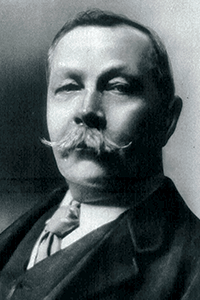Conan Doyle’s ‘caveman in a lounge suit’
By Ben Stevens H P Stevens, on 19 December 2013
With Sir Arthur Conan Doyle’s most famous creation set to return to our screens in a New Year’s Day episode of Sherlock, it was refreshing to attend a symposium on 9 December dedicated to his much less well-known character, Professor George Edward Challenger.
Most readers, if they have heard of him at all, will know Professor Challenger from his first appearance in the novel, The Lost World (1912).

Narrated by journalist Edward Malone, the novel sees the irascible professor lead an expedition to a South American plateau to prove the existence of dinosaurs there, accompanied by Malone, fellow scientist Professor Summerlee and Lord John Roxton, a hunter and adventurer.
Challenger’s adventures continued in two further novels, The Poison Belt (1913), The Land of Mist (1926) and two later short stories, When the World Screamed (1928) and The Disintegration Machine (1929).
The symposium, ‘Challenger unbound’ – ably convened by UCL PhD student Tom Ue (UCL English) – explored all five works and brought together scholars from across the UK and North America including UCL’s John Sutherland, Lord Northcliffe Professor Emeritus of Modern English Literature.
In spite of being allocated an entire day, the symposium’s programme was so extensive, attendees had to make difficult choices when it came to deciding between competing panel discussions.
New spaces for imagination
I chose ‘Challenger and Genre’, which featured papers by UCL MA student Tom Dillon, Dr Merrick Burrow (Huddersfield) and Professor Matthew M. DeForrest (Johnson C. Smith University) and examined the Challenger stories in terms of their contribution to the (then) emerging genre of science fiction/scientific romance.
Dillon, in particular, argued that the new genre offered Doyle and other writers new spaces for imagination – unrestricted by geography.
This was a much-needed outlet, as by the early 20th century, there was growing dissatisfaction with imperialism and its limitations. This means that, in some ways, The Lost World can be read as a satire on imperialism.
Doyle was certainly an advocate of reform and by having Challenger and his friends end up slaughtering a race of ape-men in the story, he clearly undermines their claims for European moral supremacy.
Roxton even remarks how “the chief ape looked the spitting image of Challenger” – a description that is echoed by Malone in When the World Screamed: “He is a primitive caveman in a lounge suit… Some people are born out of their proper century, but he is born out of his millennium.”
No room for romance?
And yet, when Doyle spoke at an event in honour of arctic explorer Robert Peary in 1910, his comments betray a certain sorrow that an age of adventure has passed:
“There had been a time when the world was full of blank spaces, and in which a man of imagination might be able to give free scope to his fancy. But owing to the ill-directed energy of [our] guest and other gentlemen of similar tendencies these spaces were rapidly being filled up; and the question was where the romance writer was to turn.”
This idea is repeated almost verbatim in The Lost World. Mr McArdle, Malone’s boss and news editor at the Daily Gazette, says: “The big blank spaces in the map are all being filled in, and there’s no room for romance anywhere.”
Challenger as doppelganger
In his keynote lecture, Professor Michael Saler (UC Davis) suggested that, while Sherlock Holmes often shares his creator’s ennui in relation to modernity, he is temporarily freed from it by having a new case to solve, as it provides a sufficient, earthly source of wonder.
Challenger, in contrast, continually seeks romance and wonder beyond the confines of the physical world. In this sense, Saler argued, he can be seen as Doyle’s twin.
Dissatisfied by modernity and Catholicism, Doyle tried to establish the empirical existence of other worlds of magic particularly through his belief in Spiritualism, which he publicly declared in 1916.
This is perhaps why he eventually chose Professor Challenger, rather than Holmes, as the character to encounter, and endorse, Spiritualism in his much-maligned novel, The Land of Mist.
A day of wonder
With such a packed programme, I obviously cannot do full justice here to what was a fascinating symposium.
Other aspects covered included how the Challenger stories fit into apocalyptic narratives; the mutually beneficial relationship that developed between Conan Doyle and the Strand Magazine; and the historical figures that provided the inspiration for Challenger and the other characters.
Ultimately, in spite of the clear critical interest it provoked among the symposium’s speakers, The Land of Mist remains, for me, the weakest of the Challenger stories, reading as a thinly-veiled tract on the subject.
In fact, despite Conan Doyle’s best efforts, the religion – and his abiding preoccupation with it – is actually given its most sympathetic hearing in Julian Barnes’ novel Arthur and George. I think I know which I’ll be re-reading over the Christmas holiday.
 Close
Close

